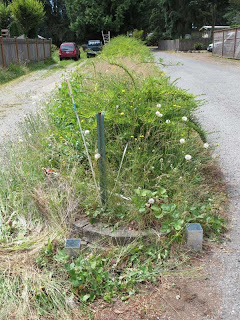I was able to grab some time on Sunday and begin installing the 4x4 pressure treated fence posts. They are eight feet long, and I'll be cutting them to the correct height at the very end. Installing the posts was surprisingly easy.
Step 1: Insert 4x4 into the stake sleeve
Step 2: Plumb the post using a post level
Step 3: Use a cordless driver to the screw post into the sleeve
I found I could make some minor plumb adjustments buy pushing and pulling on the installed post since it's basically just a big lever. It'll be interesting to see if this will mean than the fence is less stiff over the course of it's life.
After installing the posts at each end of the run, I ran a string line at the base of the fence and at six feet (the finished height of the fence. I also measured the slope of the fence over the course of the run and found that there's a two foot change in elevation. This was surprising as it sure doesn't look like that much of a slope.
Installing the rest of the posts was as easy as the first two, and the string lines made it even easier. Four of the post stakes turned out to be a little more out of line than I was comfortable with so I cut a 1/4" rabbet in the base of the post to pull it more in line with the fence. I'll go back later and insert a filler piece into the sleeve so that the post/sleeve fit is tight. I'll also stain and seal the rabbet.
It feels good to see a straight line of plumb posts. It reminds me of the summer when I was fourteen and worked on my father's fence crew. My primary duty was to empty the post holes with my post hole digger after the two-man auger team finished making the hole. But I also got to stretch a lot of chain link fencing, mix cement, and shovel gravel.
Post level on a plumb post.
I used #10 x 1 1/4" square drive pan head stainless steel tapping screws. There are sixteen per post.
Here's a photo of the full run of posts that I got done. I still have two more to do in this run.
Another angle of the run.
And here's a photo of the rabbet. The glacial gravel in the dirt caused a few of the post stakes to wander a little durning jack hammering (about a quarter to a half of an inch). The rabbet on the post base helps lessen the alignment issue. But I'm also being a bit OC. My understanding is that a quarter of an inch is an acceptable tolerance.




























